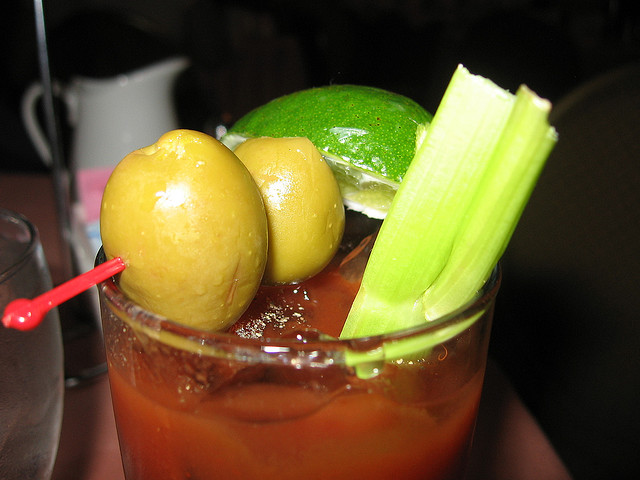( @DrinkingMadeEasy, #BloodyMary )

Drinking Made Easy FINALLY posted my article about bloody marys! I am pretty proud of this post because I inserted a little more of my personality than my previous efforts. Please give it a read:
Drinking Made Easy: Bloody Marys
Update: DME’s likes are broken, here is the whole story…
Bloody Mary recipes are like assholes…everybody has one (except for a kid I knew in 4th grade, but that is a whole other story). The tomato and vodka based drink is universally recognized, yet encourages massive variation. Last month I read a short story about the American Chemical Society (ACS) publishing guidelines on making the perfect bloody mary. I was going to do a simple article and call it a day. When I started mentioning the idea to friends and family, everyone chimed in. Suddenly I was caught in a deluge of suggestions and my head started spinning.
Where did the bloody mary even come from? The drink seems to have an unlikely origin: actor George Jessel is credited with inventing an early form of the cocktail in the 1920s. He basically mixed equal parts tomato juice and vodka. Jessel befriended a French bartender named Fernand Petoit who added salt, pepper, spices, and Worcestershire sauce. The drink caught on and people started putting their own spin on it. The origin of the name is cloudy to say the least, but could also have roots in Hollywood (named after actress Mary Pickford). Eventually the New York School of Bartending published the “definitive” recipe as:
1 oz. to 1½ oz. (30-45 ml) vodka in a highball glass filled with ice.
Fill glass with tomato juice
1 dash celery salt
1 dash ground black pepper
1 dash Tabasco sauce
2-4 dashes Worcestershire sauce
1/8 tsp. horseradish (pure, never creamed)
Dash of lemon or lime juice
Garnish with celery stalk.
While the ACS doesn’t refute any of the ingredients, from a scientific standpoint they suggest using fresh ingredients stating that the concoction deteriorates quickly. They suggest using cheaper vodka since the other ingredients will mask the alcohol’s flavor. Finally, the ACS recommends spending money on superior tomato juice since it makes up the bulk of the flavor in the drink.
I decided to test out the recommendations and invited a few respected drinking buddies over to sample. One of my guests threw a curveball by bring a pre-made bloody mary mix (sans vodka) called Zing Zang. Of course there is a backstory to this mix: it is not available in the East Coast and he had to have his brother-in-law ship him a case from Chicago. I pushed my pitcher of homemade bloody mary aside and made myself a drink using the Zing Zang. It was good and not for those with weak hearts. The mix is spicy and features huge chunks of salt and pepper floating around. It tasted fresh and was very good.
I then shifted over to my own mix. All the ingredients were highlighted: the spice of the Tabasco, the sweetness of the Worcestershire, and the sinus clearing of the horseradish. Basically, the homemade drink was really good too, and it probably helped that I knew what was in it. The question remains, which one was better?
There isn’t a right answer and there never will be.
If you grew up tossing sea salt and jumbo shrimp in your Bloody Mary, who am I to judge? If you prefer a salad in your glass over excessive amounts of vodka, that is your prerogative. If you want a drink so spicy that it melts the glass, you do what you got to do. The important thing to remember is the bloody mary allows for drinking to be socially acceptable on Sunday mornings which I am sure everyone can get behind. The next time someone hands you this delicious cocktail, don’t think about how you would have made it or what is missing. Just appreciate the fact that if an old Hollywood drunk had not shared the recipe with a French bartender, you would probably be drinking fruit punch.
